
Daphne is a genus of between 70 and 95 species of deciduous and evergreen shrubs in the family Thymelaeaceae, native to Asia, Europe and north Africa. They are noted for their scented flowers and often brightly coloured berries. Two species are used to make paper. Many species are grown in gardens as ornamental plants; the smaller species are often used in rock gardens. All parts of daphnes are poisonous, especially the berries.
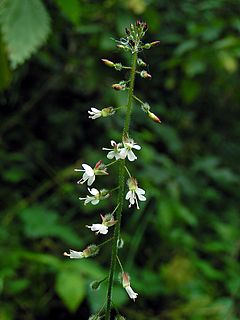
The Circaea, or enchanter's nightshades, are a genus of flowering plants in the evening primrose family Onagraceae. About two dozen taxa have been described, including eight species. Plants of the genus occur throughout the temperate and boreal forests of the Northern Hemisphere. Three taxa occur in North America: Circaea alpina, Circaea canadensis, and the hybrid Circaea × sterilis. The generic name Circaea refers to the enchantress Circe from Greek mythology who is said to have used the herb as a charm.

Selenicereus, sometimes known as moonlight cactus, is a genus of epiphytic, lithophytic, and terrestrial cacti, found in Mexico, Central America, the Caribbean and northern South America. The term night-blooming cereus is also sometimes used, but this is also used for many night-blooming cacti, including Epiphyllum and Peniocereus. In 2017, the genus Hylocereus was brought into synonymy with Selenicereus. A number of species of Selenicereus produce fruit that is eaten. The fruit, known as pitaya or pitahaya in Spanish or as dragon fruit, may be collected from the wild or the plants may be cultivated.
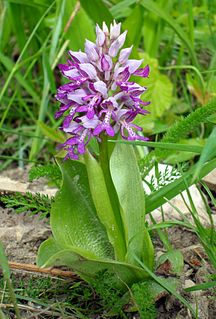
Orchis militaris, the military orchid, is a species of orchid native to Europe. It is the type species of the genus Orchis.

Arum italicum is a species of flowering herbaceous perennial plant in the family Araceae, also known as Italian arum and Italian lords-and-ladies. It is native to the Mediterranean region. It is also naturalized in Great Britain, the Netherlands, Crimea, Caucasus, Canary Islands, Madeira, Azores, Argentina, and scattered locations in America.

Bromelioideae is a subfamily of the bromeliads (Bromeliaceae). This subfamily is the most diverse, represented by the greatest number of genera with about 40, but the fewest species with 865. Most of the plants in this group are epiphytes, though some have evolved in, or will adapt to, terrestrial conditions. This subfamily features the most plant types which are commonly cultivated by people, including the pineapple.
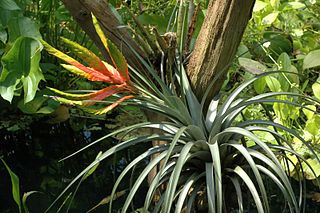
Tillandsioideae is a subfamily of plants in the bromeliad family Bromeliaceae. This subfamily contains the greatest number of species. Most are epiphytic or lithophytic, growing in trees or on rocks where they absorb water and nutrients from the air. Spanish moss of the genus Tillandsia is a well-known species. Bromeliads in the genera Guzmania and Vriesea are the more commonly cultivated members of this subfamily.

Afrothismia is a genus of plant in family Burmanniaceae, first described as a genus in 1906. It is native to tropical Africa.
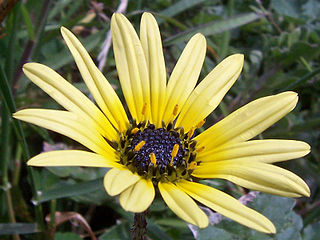
Arctotheca is a small genus of flowering plants in the aster family. They are annuals or perennials native to southern Africa. It is becoming an invasive weed in other parts of the world.

Barleria prionitis is a shrub in the family Acanthaceae, native to Island and Mainland Southeast Asia, China, the Indian Subcontinent, the Arabian Peninsula and northeastern Africa. It is widely spread as an ornamental and weed, occurring in naturalised populations around the world. It used not only as an ornamental but also as a hedge and extensively as a component of folk medicines. As a weed it is regarded as problematic in many areas.

Pteroceras is a genus of flowering plants from the orchid family, Orchidaceae. It is native to China, the Indian Subcontinent, and Southeast Asia.

Lumnitzera is an Indo-West Pacific mangrove genus in the family Combretaceae. An English common name is black mangrove. Lumnitzera, named after the German botanist, Stephan Lumnitzer (1750-1806), occurs in mangroves from East Africa to the Western Pacific, and northern Australia.
Musa banksii is a species of wild banana, native to New Guinea and Australia (Queensland), and most likely introduced to Samoa. It was first described by Ferdinand von Mueller in 1863 from plants collected in Queensland, Australia. Thereafter, taxonomists have variously treated it as a unique species or as a subspecies of Musa acuminata. The first one to note an affinity with Musa acuminata was Ernest E. Cheesman in 1948. In 1957, Norman Simmonds reclassified it as a subspecies of Musa acuminata based on extensive field observations in New Guinea, Australia, and Samoa. In 1976, George Argent chose to treat it as a species.

Syzygium forte, commonly known as flaky-barked satinash, white apple or brown satinash, is a tree in the family Myrtaceae native to New Guinea and northern Australia.
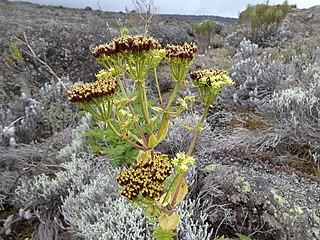
Afrosciadium is a genus of flowering plants belonging to the carrot family, Apiaceae. It was split from the genus Peucedanum in 2008 by P.J.D. Winter, et al.

Afrosciadium abyssinicum, synonym Peucedanum abyssinicum, is a member of the carrot family, Apiaceae. It is native to Ethiopia, where it grows at high elevations.

Afrosciadium articulatum, synonym Peucedanum articulatum, is a member of the carrot family, Apiaceae. It is native to northern Malawi.

Afrosciadium caffrum is a member of the carrot family, Apiaceae. It is a perennial tuberous herb native to subtropical regions in eastern South Africa.

Afrosciadium magalismontanum is a member of the carrot family, Apiaceae. It is a perennial tuberous herb native to subtropical regions in eastern South Africa and Eswatini. It has a tall, narrow stem which divides into multiple evenly-spaced branches near the top, with each branch sporting a cluster of small yellow flowers at its end.

Afrosciadium dispersum is a member of the carrot family, Apiaceae. It is a perennial tuberous herb native to tropical mountains in South Sudan, northern Uganda, and southwestern Tanzania.



















